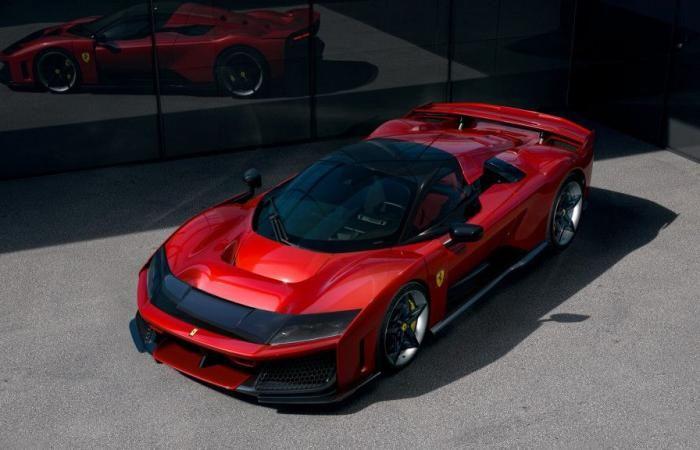From 1984, Ferrari periodically publishes a new supercar demonstrating the highest level of technology and innovation of his time. After the 288 GTOthe F40the F50, the Enzo or even the LaFerrariIt’s here F80. Like his noble predecessors, this new thoroughbred will only be produced in limited series, 799 copies.
Ferrari F80: a “pistar” heart pumped up to 1200 horsepower!
Let’s start with the entrails of the “beast”. Because a Ferrari would hardly be a Ferrari without one ADN inspired by the course for the mill that propels it. Like the 288 GTO and the F40 moved by a V8 turbo of F1 in the 1980s, the The F80 inherits a block machined for competitionthe V6 turbo hybrid animate the Hypercars 499P on the slopes of WEC et 24 Hours of Le Mans.
The powertrain, a three-liter 120° F163CF V6, alone offers a already crazy power of 900 horsepowermaking it the Ferrari engine producing the highest specific cavalry of all time (300 ch/l).
For the first time on a Ferrari, the block is completed by the technology‘e-turbo. Thanks to an electric motor installed between the turbine and the compressor of each turbo, this system makes it possible to obtain a specific power and instant response at low revs.
These electric motors used for the F80 – two on the front axle and one on the rear (and fashion MGU-K, another legacy of F1) – are the first developed, tested and manufactured entirely by Ferrari.
They allow you to extract 300 ch in addition for a the total cavalry increased to 1,200 equines, either Ithe most powerful engine architecture in the history of Maranello ! Coupled with a F1 dual-clutch 8-speed gearbox, this block takes up the F80 of 0 to 100 km/h in 2.15 secondsfrom 0 to 200 km/h in 5.75 s, for a maximum speed 350 km/h.
The F80 also inherits the system MGU-H, allowing energy to be generated from excesskinetic energy of the rotation of the turbines created by the exhaust gases, with a application e-turbo custom made.
The heart of the energy storage system – the high-voltage battery with a maximum power of 242 kW — was designed on three principles: the chemistry of lithium batteries derived from F1, the use of carbon fiber for the unibody case and a patented design and assembly method (pack cell) which minimizes weight and volume.
Ferrari F80: a concentrate of technologies from racing
Aerodynamic plays a key role here with solutions, inspired by racing and aerospacesuch as active rear spoilerthe rear diffuser, the flat bottom, the front wing of the triplane and the S-duct who work together to generate 1,050 kilos of downforce at 250 km/h.
This result is further improved by the suspension active, which helps generate ground effect. Performance is optimized by the electric front axle, which allows you to use the four wheel drive to exploit even more torque and power, as well as thanks new brakes with technology CCM-R Plus derived from motorsport.
The front is inspired by concepts used in F1 and WEC. On the one hand, the reclined driving positionsimilar to those of racing cars, made it possible to design a chassis with a high central keelwhile the layout of the cooling system freed up the entire central part of the car, maximizing the usable space.
The central volume of the nose serves as the main blueprint for the front fender dimensions.
Ferrari F80: one diffuser of almost 2 meters!
Inside the S-shaped conduit, two shutters follow the main profile to complete the triplane aileron configuration whose curves and slits are inspired by 499P. Aerodynamic efficiency depends on how well the triplane aileron works in harmony with the S-duct and the high central keel.
Aerodynamic balance is also ensured by the active suspensionwhich monitors the vehicle’s attitude in real time and adjusts the distance between the underbody and the road according to driving conditions.
Rear area aerodynamic performance are the result of the combined action of diffuser and rear spoiler systemthe latter displaying a record length of 1,800 mmto generate a huge depression zone under the car.
The active spoiler is the most distinctive aerodynamic element of the F80 on a visual level. It actively not only adjusts its height, but also controls the angle of attackfor one Adjustable downforce and drag.
In the configuration High downforceused when braking, in turns and in curves, the drift takes an angle of 11° relative to the direction of the air flow for generate more than 180 kilos of downforce at 250 km/h.
Ferrari F80: onenew era of design for the brand
Like all supercars before it, the The F80 marks the start of a new era of design for Ferrari. It is the fruit of a creative design study who led the team Hairdressing center operate a radical change in the visual language of the brandwith the starting pointaesthetics of single-seaters of F1 of the Scuderia.
The hull and other chassis elements were developed according to a multi-material approach. The cell and the roof are in place carbon fiber and other composite materials, while the front and rear subframes are made of aluminium and attached to the hull by titanium screw. At the rear is an additional aluminum subframe, attached to the main rear subframe using screws, to transport the battery.
Completely new, the the bodywork is carbon fiber using technology derived from F1 and other motorsports. The front cover features a S-duct composed of a fixed element connecting the two front wings.
As on the LaFerrari, gullwing doors feature a two-axis hinge mechanism of rotation allowing them to open vertically to an angle of almost 90°. The rear engine cover includes six hot air exhaust slots from the V6 and a grill that also evacuates air.
Ferrari F80: stylish touches in homage to the F40
While the front headlights are hidden in a visor element, the short-tail rear features two different configurations: with themovable fin folded or deployed. The taillights are integrated into a two-layer structure consisting of the rear bumper and the spoiler, creating a sandwich effect.
The architecture of the whole is defined by a dihedral effective section the two lower corners of which are firmly anchored on the wheels. Profile view, the the rear section features a sculpted flow which highlights the musculature of the rear wing. The front part is defined by more architectural elements like the wheel arch finished with a vertical panel above the door, a homage to the visual language of the F40.
The asymmetrical layout of the passenger compartment made it possible to optimize each side of the hull separately: the driver’s side is equipped with a adjustable seat, while the passenger side has a fixed seat, used to save weight.
Rising from the volumes of the lower body, the passenger compartment is a floating bubble with unexpected volumes. 50 mm lower than that of LaFerrari, the cabin helps broaden the shoulders of the car to give the cockpit a more compact appearance.
Ferrari F80: single-seater cockpit and new steering wheel
at theinterior of the F80, the compact interior proportions were made possible by the choice of a cockpit inspired by a single-seater in “1+” mode, centered around the driver. The passenger seat is so well integrated into the trim that it almost disappears from view.
A longitudinal shift in the position of the seats made it possible to move that of the passenger back in relation to the driver, what has reduces interior space without penalizing ergonomics and comfort. This solution allowed the designers to offer the car a smaller cabin and reduce the frontal section of the car.
The F80 is also equipped with a new steering wheel developed specifically, which will appear on future Ferrari road models. Slightly smaller than its predecessor and equipped with flattened edges at top and bottomthe steering wheel also has a little boss. Its lateral areas are optimized to ensure better grip.
THE the physical buttons on the right and left spokes of the steering wheel are back, replacing the digital layout used by Ferrari in recent years with easier-to-use buttons.
Discover the new Ferrari F80, produced in limited series of 799 copies of a unit value of 3.5 million euros, in pictures in our slideshow above.






